The benefits and harms of boiled pumpkin: what is good about a boiled vegetable, how to properly prepare and eat it
Pumpkin enjoys well-deserved popularity on all continents. They cook it in different ways: boil it, bake it, stew it, eat it raw, prepare snacks, season it with spices, herbs, butter and honey. It is useful in any form for adults and children.
Of course, the maximum benefit can be obtained from the raw pulp, but the cooked vegetable also contains the same minerals and vitamins. In this article we will talk about the benefits and harms of boiled pumpkin, consumption rates and contraindications.
Boiled pumpkin
Pumpkin is a valuable melon crop with a rich chemical composition. It is very easy to prepare at home. Boiled pulp makes excellent porridges, soups, and purees for baby food. The advantage of this method of culinary processing is the preservation of the beneficial qualities inherent in raw vegetable.
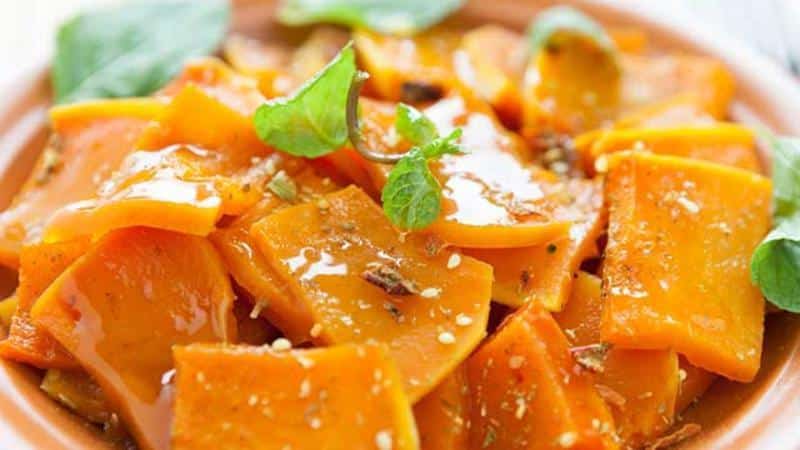
Benefits and harms
Pumpkin contains a lot of useful elements that have a beneficial effect on all systems of the human body.
Vitamin T, which is found in large quantities in pumpkin, helps digest meat, legumes, and vegetables with a high content of coarse fiber.
Copper, iron, calcium, cobalt and zinc increase hemoglobin, strengthen bones, and strengthen the immune system.
Fiber accelerates the elimination of toxins and cholesterol and helps reduce excess weight.
Boiled pumpkin is suitable for baby food from an early age. The bright orange shade attracts the attention of little ones. Mashed potatoes, cereals and soups are often liked by little picky eaters.They perfectly saturate and replenish vitamins and minerals.
Boiled pulp helps pregnant women fight edema. This is facilitated by potassium, which gently and safely removes excess fluid from tissues.
Boiled pumpkin masks can replace many expensive cosmetic products. They fill the skin with moisture, nourish, vitaminize and smooth out the network of fine wrinkles.
In addition to its beneficial effects on the body, boiled pumpkin can harm people suffering from:
- diabetes mellitus (the pulp contains a lot of sucrose and fructose, which lead to sharp jumps in insulin);
- ulcerative lesions of the gastrointestinal tract in the acute stage;
- chronic diarrhea (pumpkin has a laxative effect).
Reference. Pumpkin ban for stomach ulcers refers more to a raw vegetable. Boiled pulp is allowed to be consumed in small quantities.
Compound
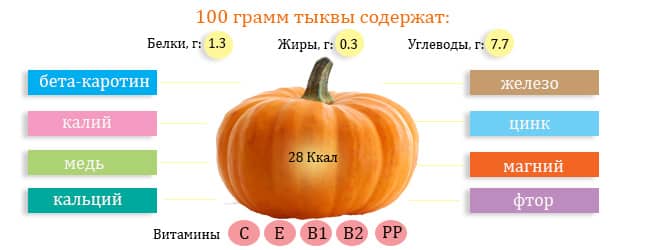
The pulp of boiled pumpkin contains almost the same nutrients as the raw vegetable:
- vitamin A - useful for myopia, supports healthy teeth, skin, nails and hair;
- B vitamins - normalize sugar levels, strengthen the immune system, increase resistance to stress, improve the functioning of the digestive tract;
- vitamin D - forms and strengthens bones, inhibits the development of cancer cells, invigorates;
- vitamin K - prevents the leaching of minerals from bones;
- vitamin PP - normalizes the state of the nervous system;
- Vitamin T - helps digest food;
- iron - increases hemoglobin;
- magnesium - regulates the functioning of the heart muscle;
- cobalt - responsible for hematopoiesis;
- zinc - rejuvenates, relieves inflammation of the prostate gland, relieves sexual dysfunction;
- copper - helps the body absorb iron.
KBJU and glycemic index
Nutrients:
- proteins – 1 g;
- fats – 1 g;
- carbohydrates – 4.4 g.
How many calories are in boiled pumpkin? Per 100 g of pulp - only 28 kcal.
Glycemic index of boiled pulp is 75 units. This is a fairly high figure, so diabetics are advised to consume pumpkin in limited quantities. For them, the beneficial effect of pumpkin on the pancreas is especially noteworthy.
Reference. The glycemic index (GI) is an indicator that displays the rate at which blood sugar levels increase when specific foods are consumed. The body absorbs fast carbohydrates quickly. The jumping glucose level signals the pancreas to produce a portion of insulin.
Benefits for various diseases
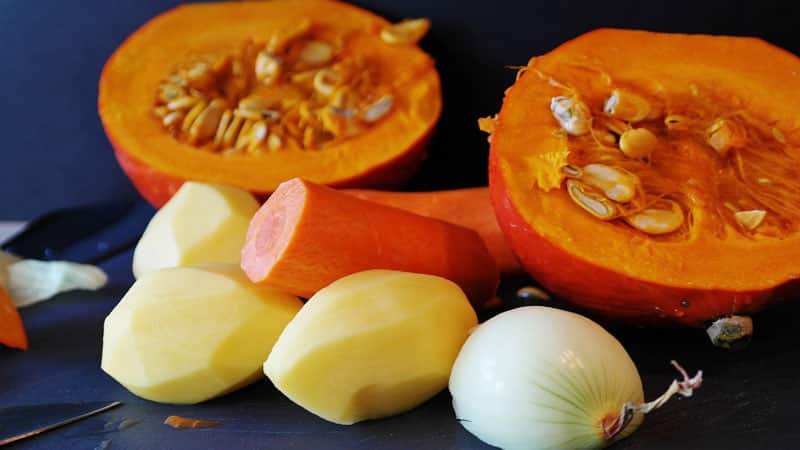
It is recommended to include boiled pumpkin in the menu for the following diseases:
- gout;
- atherosclerosis;
- pathologies of the intestines, kidneys, liver, gall bladder;
- constipation;
- diabetes;
- obesity;
- skin lesions (dermatitis, eczema);
- diseases of the heart and blood vessels.
When losing weight
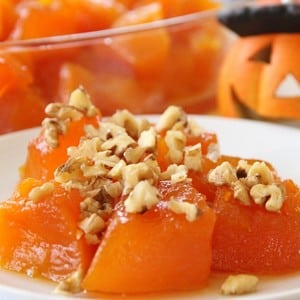 Low calorie content, high fiber and pectin content help you easily lose weight and remove excess water, which delays the weight loss process.
Low calorie content, high fiber and pectin content help you easily lose weight and remove excess water, which delays the weight loss process.
Pumpkin pulp increases intestinal contraction and helps eliminate “bad” cholesterol. Coarse fiber, moving through the digestive tract, cleanses the walls of waste and toxins.
Just replace starchy vegetables with boiled pumpkin during your weight loss period, lose weight easily and without failure.
For men
Zinc in pulp regulates testosterone production, improves the quality of seminal fluid, prevents the development of prostatitis, and eliminates problems with urination.
For women
The vegetable is healthy and for female representatives. Due to the high content of carotenoids, pumpkin provides an even tan and improves complexion, helps remove deposits in fat traps (sides, hips, back). During menopause, it prevents the development of complications (cardiac dysfunction, osteochondrosis due to a decrease in estrogen).
Folic acid, calcium and phosphorus support a woman’s body during pregnancy and contribute to the full development of the fetus.
Vitamin E reduces the risk of gynecological diseases.
For children
100 g of boiled pumpkin puree contains the daily requirement of beta-carotene for children. The vitamin is necessary to maintain visual function, bone mineralization, and improve immunity.
Pediatricians recommend introducing pumpkin into the diet of hyperactive children. The minerals and vitamins it contains have a beneficial effect on sleep, calm the nervous system, and increase perseverance and attentiveness.
How to cook and how to use
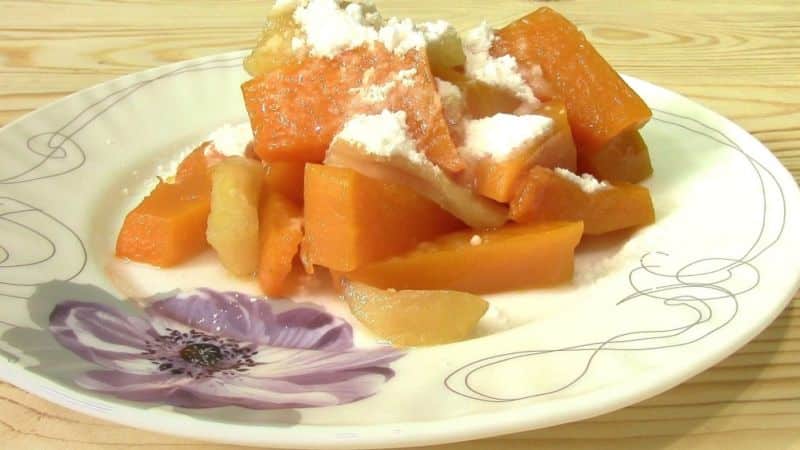
You can cook boiled pumpkin in a saucepan, double boiler, slow cooker, or microwave.
To make the vegetable tasty and retain maximum nutrients, use our tips:
- Wash the fruit with warm water, cut into pieces, remove the bark and remove the fibrous core with seeds. Seeds do not throw it away, but dry it. They contain no less useful substances than the pulp.
- Cut the pulp into pieces and cook in plain water, milk or mix them in equal proportions.
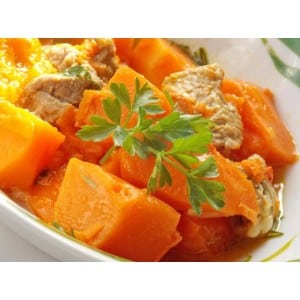
- To maintain its shape, generously brush with butter.
- Salt and bring the water to a boil before adding the pulp. In cold water, the pumpkin takes longer to cook and becomes very soft.
- The ratio of liquid to vegetable is 2:1, otherwise the product will cook unevenly.
- Check doneness with a fork or knife.If the flesh is easily pierced, it is ready.
- At the end of cooking, place the pumpkin in a colander. Do not leave in water under any circumstances if you want to preserve the vitamins and shape of the pieces.
- Add a little vegetable oil to the water. This will help the flesh cook evenly.
- Cook the pumpkin covered and over medium heat.
- In a multicooker you can cook in the “Steam” or “Soup” mode. Maximum cooking time is 30 minutes.
- To prepare pumpkin for desserts, add sugar to the water instead. salt, cinnamon, vanilla, star anise.
Cooking time:
- in a saucepan - 30 minutes;
- in a slow cooker – 35 minutes;
- in a double boiler – 30 minutes;
- in the microwave - in two stages of 10 minutes each;
- in a pressure cooker - 25 minutes.
Important! For children, boil the pumpkin until completely softened.
Norm per day
The norm for boiled pumpkin consumption for healthy people is 500 g.
The norm for diabetics is 200-300 g per day, which must be divided into small portions.
Contraindications for use
It is recommended to completely exclude boiled pumpkin from the diet if:
- diseases of the gastrointestinal tract and in the acute stage, in chronic form;
- allergic reaction to the product;
- chronic diarrhea.
Reference. For diabetes mellitus, boiled pumpkin is carefully introduced into the diet in small quantities only after consultation with a doctor, constantly monitoring sugar levels.
Stewed and boiled pumpkin - is there a difference?
Boiled and stewed pumpkin have the same calorie content and chemical composition. With these cooking methods, nutrients and taste are preserved.
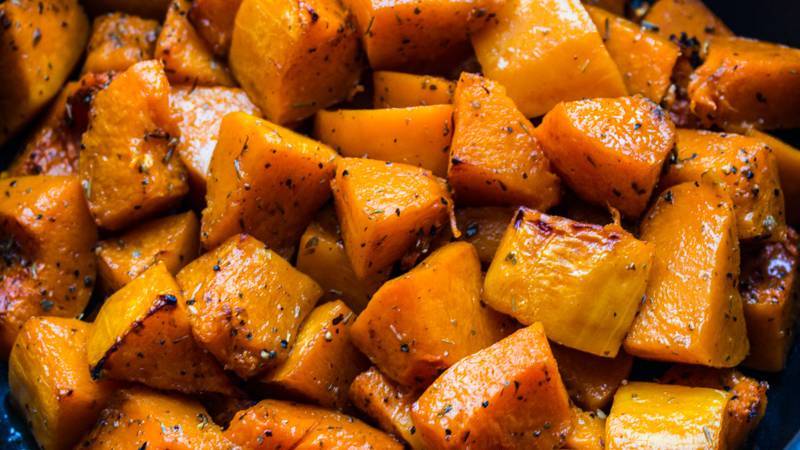
Which pumpkin is healthier: raw, boiled or stewed?
Pumpkin is equally useful in any form. The difference is that in the raw pulp the chemical composition and coarse fiber are completely preserved. Therefore, this product can be safely consumed by people who do not have problems with the digestive and endocrine systems, receiving maximum health benefits.
Boiled or stewed pumpkin is certainly rich in vitamins and minerals. Gentle heat treatment allows you to preserve the beneficial properties of the vegetable. Cooked pulp is gentler on the intestines and easier to digest. Even diabetics and small children are allowed to eat boiled pumpkin.
Conclusion
It is difficult to answer unequivocally which pumpkin is healthier - raw, boiled or stewed. For healthy people there is no significant difference. It's a matter of taste: some enjoy drinking a glass of fresh juice, others like pumpkin porridge. In order not to harm the body and receive only benefits, do not neglect the recommendations of specialists on its use and listen to your own feelings.